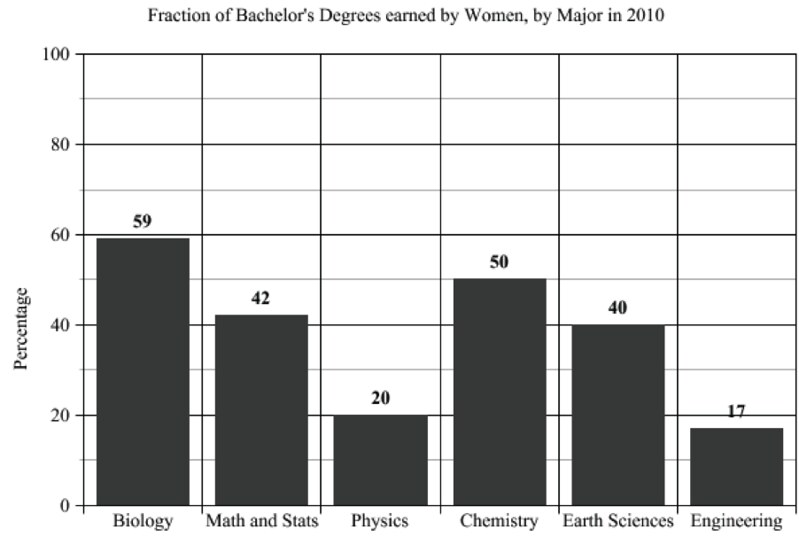
A new tutorial on campus is sparking conversations about gender relations within New College’s Natural Sciences Department. Sponsored by Associate Professor of Physical Chemistry Steven Shipman and titled “Gender in Science,” the course aims to discuss the greater relationship that gender has to experiences in the field of science.
Thesis student and biology AOC Em Eilbert spearheaded the tutorial this semester.
“New College is definitely more accepting [of women in science], but I still feel as though I had to work harder to prove myself,” Eilbert said. “I feel like there’s this idea that gender isn’t a problem here and it is.”
National statistics show a trend of underrepresented women in STEM (Science, Technology, Engineering and Math) fields. According to the American Physical Society, in 2010 about 40 percent of STEM degrees were awarded to women. A greater breakdown shows how the numbers change among fields – during that same year, women earned about 60 percent of the biology degrees and less than 20 percent of the engineering degrees.
The numbers at New College show a slightly different tale: legally defined females – a distinction that is important to make to accommodate non-binary students – made up 64 percent of the 2013 graduating class, and 61 percent of those graduating with a degree in a Natural Sciences field. A breakdown by individual AOC is not available due to NCF’s exceptionally small size, and the 61 percent hardly represents the full story.
Among STEM degrees, engineering and physics are the most male-dominated degrees, clocking in at 83 percent and 80 percent men respectively. They are also among some of the most lucrative fields, with starting salaries for engineers averaging about $60,000 with a high outlier of $98,000, according to PayScale. Physics majors will enter the job market with salaries at about $50,000. Biology, the only female-led field, clocks in at about $40,000, one of the lowest starting salaries in the STEM field. Chemistry majors, about 50 percent of which are female, do not break $45,000.
“Biology is panned off as being the easiest science, like bio students aren’t real scientists, like they’re less intelligent,” Eilbert said, explaining the different values placed on the variety of STEM fields. “That’s really frustrating to me.”
Additionally, math-intensive fields are historically, extremely male-dominated, and it is not very different at New College.
“The math-heavy courses do not bring in women,” second-year Stefan Drakulich said.
One of the most commonly required courses in the natural sciences at New College is Physics, and there are typically two ways of fulfilling that requirement: a combination of Physics I and Physics II, or an Honors Physics I and II combo.
“[Physics I] is very elementary,” Drakulich said. “Honors Physics is the one where you’re actually learning Physics.”
The Honors Physics courses are also the math-heavy course, loaded with additional calculus requirements not found in the Physics I and II courses, and are typically sparse of anyone except men.
The natural sciences professors at New College are also often cited when students explain their relationship to the field. Male natural sciences professors significantly outnumber female professors in the department.
“I do think that there should be more encouragement for women,” Drakulich said. “I saw a statistic that showed that the interest women have in any given area of physics or math is directly correlated with how many other women are in the field.”
Second-year Anne-Lise Emig corroborated that idea. “Having female role models is important,” Emig said, citing her recent ISP, in which she worked with a number of female scientists in a research lab. “I’ve found that encouragement helps me the most [and] the lack of female scientists is discouraging.”
Gender relation discussions among professors in the natural sciences are not limited to women, however. Third-year and marine biology AOC Heath Barnes, who identifies as non-binary – a person who does not identify as male or female – also had stories to share about experiences with natural sciences professors. Professors at New College, Barnes said, can often have trouble respecting “they” pronouns, and some professors can ostracize femininity in the classroom. “Sometimes I’ll hear professors criticize someone for wearing a dress in the lab, even if it meets all the requirements,” Barnes said.
“A lot of Nat Sci people, students and professors, feel as though they’re separated from the gender conversation, and they’re not,” Barnes added.
Drakulich explained that he had heard anecdotes about a New College professor who was discriminatory towards male students but, according to Drakulich, “I personally didn’t notice anything … You have to learn how to work [certain professors].”
The conversation is ongoing, and much of it will be explored over the next few weeks in the Gender in Science tutorial. “I want to increase knowledge and work towards finding new ways to avoid these problems,” Eilbert said.
This is the third year in a row that Shipman has sponsored the tutorial, but it is the first time that the class is being called Gender in Science. The previous course, Women in Science, focused solely on women and had little crossover for men and non-binary individuals. Although the tutorial is available for class credit, students have the option of attending the meeting with no contractual commitments.
“This tutorial is for everyone,” Eilbert said. “Every week anyone is welcome to stop by.”
“I feel strongly that science is for everyone,” Shipman said. “Not just for men.”
Information from this article was taken from payscale.com and aps.org
